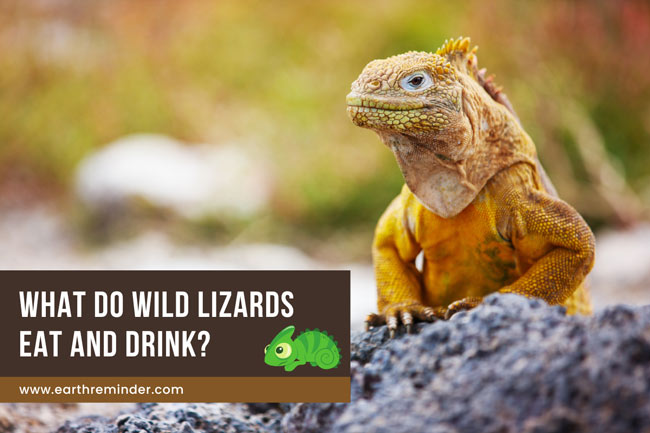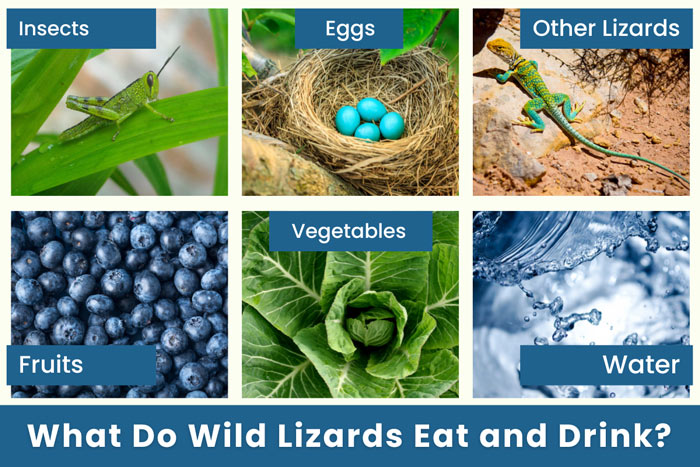What do wild lizards eat? It’s a question many people ask. Wild lizards are found in many parts of the world, and their diet is as diverse as the places they inhabit. There are a lot of different foods they can eat. Their diet depends on their size, species, and where they live. Here, we’ll learn what wild lizards eat and drink based on their categories.
Table of Contents
What Do Wild Lizards Eat?
Based on what is offered to them, lizards are opportunistic eaters who will eat lots of different things. Their primary food sources are insects, spiders, and other invertebrates. As they give the lizard vital elements like protein, fat, and vitamins, such creatures are crucial to its diet. If fruit is offered, lizards will eat it as well. Fruit gives lizards the sugars or carbohydrates they need to keep their energy levels high. Occasionally, lizards will also eat plants! Plants remain an excellent source of fiber for the lizard, even though they don’t contain as many nutrients as insects and fruits. Lets dive deeper into the topic.
What Do Lizards Eat in the Wild?
In the wild, lizards consume various foods, and their diets change depending on the species and location. Lizard diets vary depending on where they live, since they may live in deserts, ponds, woodlands, and even plains. Wild lizards eat the following things:
Insects
In the wild, lizards of several different types eat insects. Every place has a diverse variety of insects. Due to their abundance in the environment, geckos and other lizards frequently eat crickets, grasshoppers, ants, spiders, and cockroaches. Since they consume termites and other harmful insects, small lizards like fence lizards and skinks are considered valuable wildlife near people’s homes. Certain insects, like lightning bugs, are poisonous to some lizard species.
“Did you know that cockroaches affect our surroundings? Find out what cockroaches do for the environment?”
Eggs
Lizards frequently break into other animal’s and birds’ nests and take their eggs. Eggs are simple to steal and lizards don’t have to work too hard. The kind of eggs they steal depends on what animals lay eggs in their habitat. One kind of lizard which steals eggs for nourishment is the Gila monster.
Other Lizards
Several lizard species consume other lizards, including members of the same species. A kind of lizard known as a collared lizard will frequently consume other lizards in the wild as part of their diet. While cannibalism among lizards isn’t common, it might happen sometimes.
Fruits and Plants
Certain lizards are omnivores in nature and will eat small creatures and vegetables. Certain lizards, such as the green iguana, are mainly herbivorous and don’t eat meat. For example, new plant shoots or soft fruits (blueberries, strawberries, etc. in moderation) are common food for green iguanas in the wild.
What Do Wild Lizards Drink?
All lizards need water to survive. Most lizards get water by drinking water, but some can absorb it through their skin. Certain lizard species that live in arid environments have evolved to get their water from food and the moisture in the air, so they may not have to drink more than other species. Most of the water wild lizards consume comes from the insects, fruits, and small animals they consume as food. But they also require access to clean water so they can drink and stay hydrated. Lizards can drink from tiny pools of water, dew on plants, and even rainwater which gathers in gaps or leaves in the wild.
“Some lizards live near ponds, like crocodile lizards. Find out more about the pond ecosystem: types, food chain, animals, and plants.”
What to Feed a Wild Lizard?
Understanding your lizard’s dietary needs is the first step in deciding what to feed it. herbivores, Insectivores, and omnivores are three categories for wild lizards. Insectivores have been the most frequent, but there are numerous more. The everyday foods that you can feed a wild lizard are mentioned below:
Herbivores (Plant-Eating Lizards)
These lizards eat plants and need a varied diet. Mix different types of leafy greens, like kale, dandelion greens, mustard greens, and turnip greens. The lizards also eat vegetables like shredded carrots and squash. Also, they can eat zucchini occasionally, but not regularly. A few fruits like strawberries, blueberries, and apples can also be eaten by Lizards. Feeding too much fruit can be harmful. Also, avoid citrus fruits. Lizards can get sick from citric acid and sugar. You shouldn’t give your bearded dragon citrus fruit. Their sugar content is high, and the acid in the fruit is too acidic for them.
Insectivores (Insect-Eating Lizards)
These lizards eat insects, and they need protein-rich bugs in their diet. You can get crickets and mealworms at pet stores. Lizards also eat other Insects like earthworms, silkworms, and dubia roaches. Sometimes, you can also sprinkle insects with reptile calcium powder to give them extra nutrition if you feed them.
Omnivores (Plant and Insect-Eating Lizards)
These lizards have a diverse diet and need both plant and animal food. As we discussed above, you can combine the foods of herbivores and insectivores. A good balance is an equal mix of insects and plants, but it also depends on the species.
“Lizards are reptiles. Explore the details of animal classification, from kingdom to species.”
Conclusion
Lizards diet in the wild depends on their species, environment, or available resources. In other words, lizards are opportunistic feeders. Some lizards only eat plant matter and are solely herbivorous, while others are predominantly carnivorous and eat insects, small mammals, birds, and other lizards. Several lizard species evolved into omnivores, which means they consumed both animals and plants. You have to know a lizard’s natural habitat and its physical and behavioral traits to figure out what it eats. Therefore, providing a balanced diet is important for lizards.
General Tips: Make sure you don’t overfeed wild lizards. Don’t feed them too much, because overfeeding can make them dependent. If you don’t know what kind of lizards you have in your area, ask a local expert. Make a lizard-friendly garden with native plants and hiding spots instead of feeding them. Always remember, feeding wild lizards is bad for them, and it’s bad for the environment too. If you are concerned about the health of a lizard, you should consult a wildlife expert right away.

